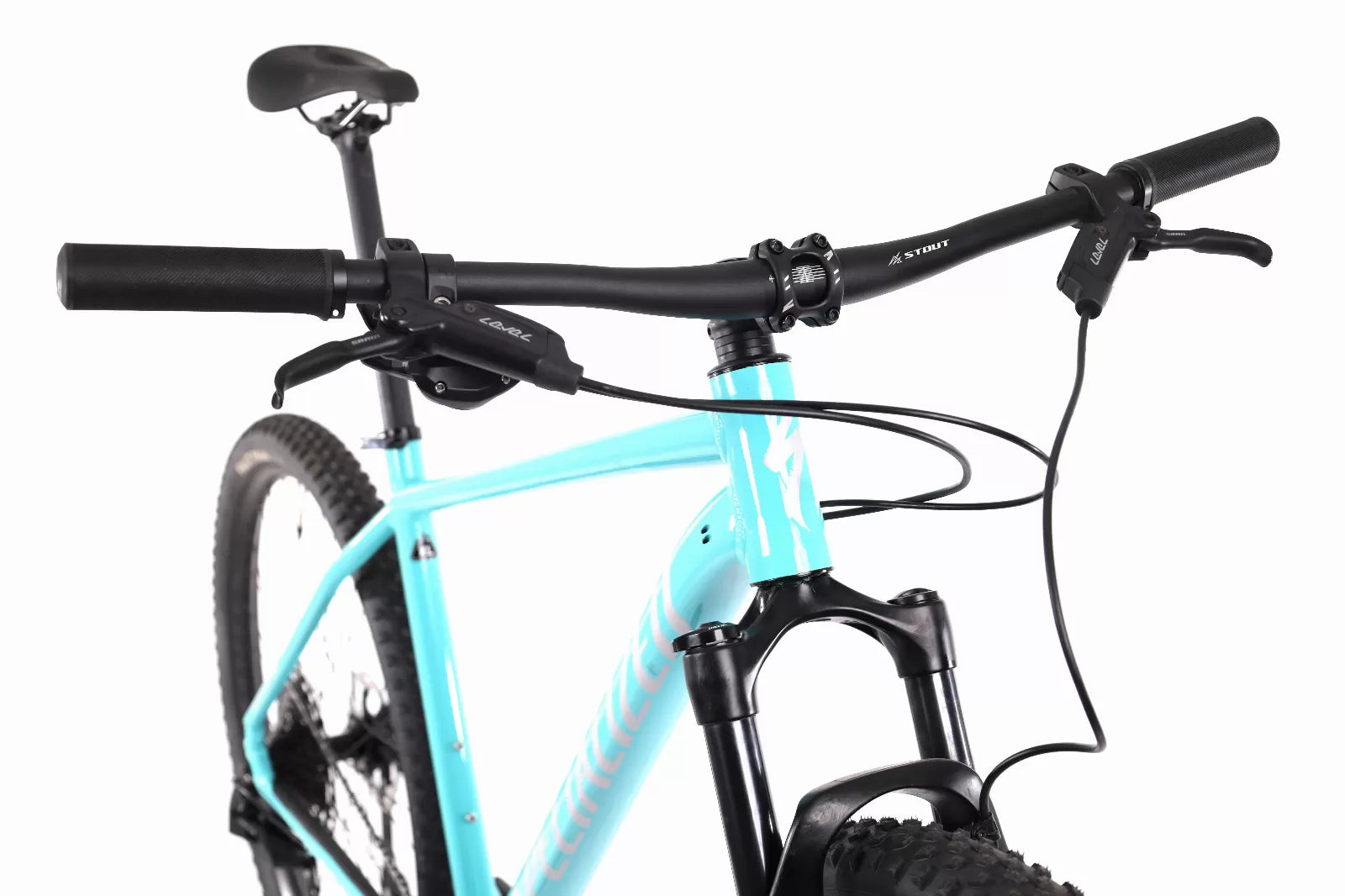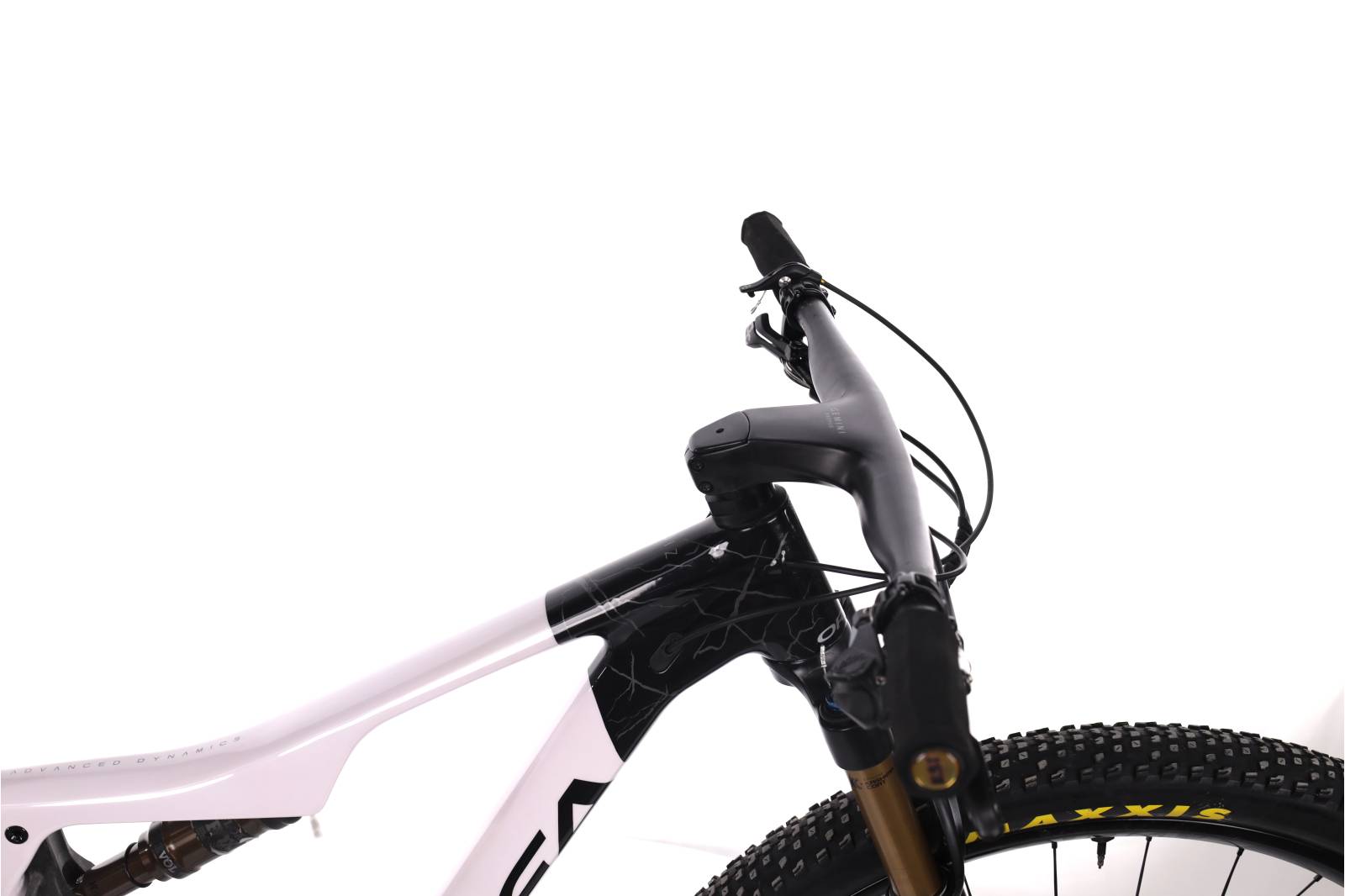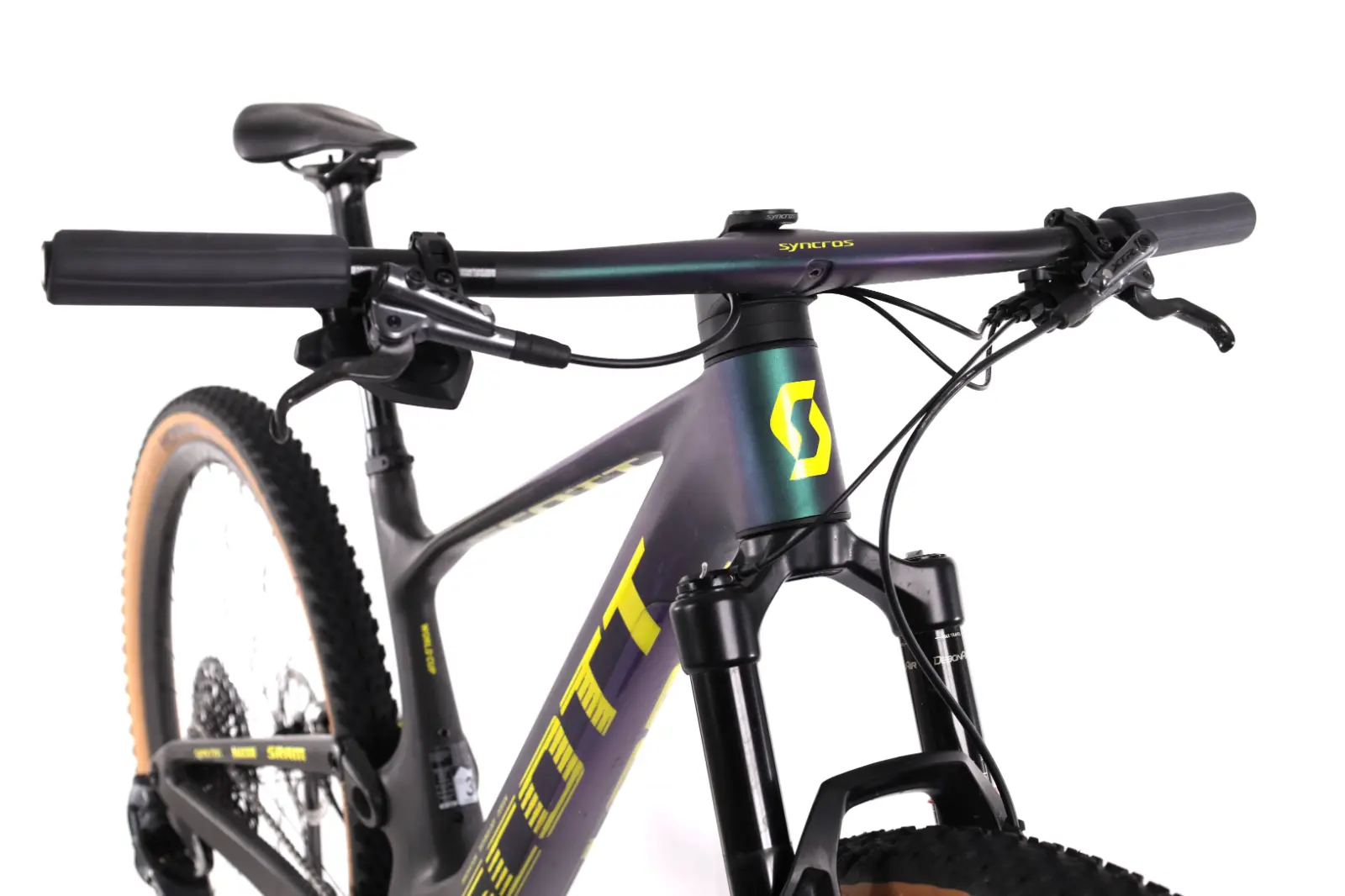We are going to tell you what you should keep in mind when buying a handlebar for your mountain bike
. Of all the contact points on a mountain bike, the handlebar is possibly the most important. Not only does it serve to control the direction of the bike, but it also has a great impact on maneuverability and riding comfort. Handlebars come in different shapes, sizes, bends, and materials, resulting in different levels of control, comfort, and performance. In fact, almost without us noticing, it is one of the components that has evolved the most in recent years.
👉 At what height should you place the handlebar of your bike?
Mounting different handlebars on the same bike can drastically change your riding experience. For this reason, we are going to detail some things you should keep in mind to choose the handlebar you really need. We are aware, in any case, that many times it is not possible to try the handlebar of a new bike before handing over the money. But that is something beyond our control.
The material of the handlebar
Mountain bike handlebars, with few exceptions, are made of aluminum or carbon. There are also titanium ones, but they are marginal. The differences, to start with, are weight and price. You can find carbon handlebars starting at around 125 euros, while their aluminum equivalents will be around 50-75 euros. The stiffness of carbon differs greatly compared to aluminum. Handlebars made from this material absorb terrain irregularities better and are lighter. However, their manufacturing is more expensive and, generally, they are less durable than aluminum ones.
If you are concerned about weight, a carbon handlebar will be your ideal choice.
On the other hand, aluminum handlebars are almost eternal. If they fail, they do not collapse as can happen with carbon, but rather tend to bend and can even be repaired. Also, they are more affordable. However, they can be too stiff; especially with 35 mm diameters (we will talk about this measurement later). Ideally, a handlebar should flex slightly (vertically) when the bike hits bumps in the terrain.

The height and angles of the handlebar: rise and sweep
The rise and sweep are the elements that give the handlebar its final appearance. But much more importantly: they influence the comfort of the rider on the bike and their riding style.
The importance of rise
The rise It is the rise of the handlebar and is indicated in millimeters. The term refers to the height difference between the center of the handlebar and its grips; that is, a handlebar with rise is a double-height handlebar. In recent times, handlebars with generous rise are trending. In disciplines such as Enduro
, they usually range between 20 and 40 mm. A greater rise provides a more comfortable position. It also makes it easier to lift the front wheel during descents and allows for a wider field of vision because the posture is more upright. In specialties such as XC, it is common for the rise to be absent. In this case, we talk about flat handlebars or flatbars. In any case, this measurement will almost never be greater than 20-25 mm on Cross-Country bikes
. Everything depends on the position you are looking for on the bike. The lower the rise, the more aggressive your position on the bike will be. Your body weight will be pulled downwards and forwards, so you will feel a more direct connection with the front wheel. As the rise increases, some sensitivity is lost and you need to play more with your body weight. Let's say that more dynamism is required on the bike.
The importance of sweep
Closely related to rise is the sweep or handlebar curvature. This curvature has two possible variants: the angle that the handlebar forms upwards (upsweep) and the one it can form backwards (backsweep). The upsweep measures in degrees the angle between the centerline of the handlebar and the grips: it reflects how the handlebar tips tilt upwards from the horizontal. Normally, on a mountain bike it is about 5°. This measurement is more important in disciplines like Enduro and All-Mountain. The backsweep is just as relevant or even more so.
Remember: it is the angle or curvature that the handlebar forms towards the rider's body, and it is more visible if we look at it from above. A generous backsweep provides extra comfort by promoting a more upright posture. It is also useful for riders with short arms who ride a bike with a long reach or top tube. In this case, the angle usually ranges between 7° and 10°; the most common measurement is 8°.
These values are a matter of comfort.

A minimal variation will affect the way you grip the handlebar. Therefore, before buying a new handlebar, it is advisable to know the measurements you are currently using in order to make the right purchase.
The width of the handlebar
The width of the handlebar of an MTB is a very personal measurement. A poor choice can harm our riding, but also our physical condition, causing overload in the back, forearms, or wrists. As a general rule, a wide handlebar provides maneuverability, stability on descents, and balance while pedaling in an upright position. In addition, it allows you to open up the ribcage and breathe better. On the other hand, a narrow handlebar makes it easier to ride on narrow trails and provides a more aerodynamic position in fast sections, where navigation is important. In this case, small handlebar movements cause large oscillations of the front wheel, making the bike more nervous. Therefore: what is the perfect width for my MTB handlebar? It will depend on three factors: the rider's wingspan, riding style, and terrain conditions.
The requirements of a 1.90 m cyclist will be different from those of a 1.60 m cyclist. In general, a smaller cyclist will use a shorter handlebar; shoulder width is the measurement that will determine this aspect. As we have said, riding style also matters. Normally, a Rally or XC biker will use a narrower handlebar than someone who practices DH. As the handlebar widens, we gain stability. But a handlebar that is too wide can be harmful to our muscles and joints.
A handlebar that is too wide can be harmful to our muscles and joints.
As a rule, a narrow handlebar is less stable, but it can provide a better position on the bike for endurance races and many hours of pedaling. The last factor to consider when choosing handlebar width is the terrain. If you are used to riding on tight trails, a narrow handlebar may be more useful. In short, experiment a little, take these factors into account, and find what works best for you. Surely, it will be very different from what your riding buddies need.
There are some formulas that are often used frequently. They are not fixed rules, but do you want to know some? Multiply your height in centimeters by 4.40 if you are a man, and by 4.20 if you are a woman. The result will be the maximum recommended handlebar size for you. Another classic option is to measure the distance between the shoulder joint and the tip of the longest finger of the hand, which will result in the ideal width.
Multiply your height in centimeters by 4.40 if you are a man, and by 4.20 if you are a woman. The result will be the maximum recommended handlebar size for you.
Do you want a recommendation? Start by choosing a wide handlebar (whether aluminum or carbon), try it, and if you see it necessary, take the bike to a workshop to have it cut. Today, handlebars come in widths of 800 or 780 mm and are designed precisely for this; they usually have cutting lines every few mm to make the operation easy. As a curiosity, the width of the handlebars used by bikers often surprises Professionals who participate in the EWS (Enduro World Series) or the Downhill World Cup. Surely, they are narrower than you might imagine. Full-width handlebars (800 mm), and even 790 mm, are almost non-existent. We would say that the average is around 770-780 mm. But there are many professionals who use 760 mm, and even 750 mm wide handlebars. If we talk about less extreme disciplines, 720 mm is a measurement that is increasingly common among those who compete in XC.
The importance of handlebar diameter: 35 vs 31.8 mm
In recent years, the industry has seen the emergence of handlebars with a diameter of 35 mm (measured in the central area, where they attach to the stem) instead of the classic 31.8 mm size. Regardless of these values, the diameter of the handlebar narrows to 22.2 mm at the ends. This is a trend more typical of high-end ranges, and more common in the most extreme disciplines of MTB, such as Enduro and Downhill. Both measurements have advantages and disadvantages, although for an inexperienced cyclist they may be irrelevant. In general, handlebars and stems with a larger diameter will be stiffer and more durable. But keep in mind that more stiffness is not always the right answer for our riding style.

It is important to have a combination of handlebar and stem that, in turn, is compatible with the vibrations of the terrain. A 35 mm diameter handlebar can be lighter than a 31.8 mm one, while maintaining the same strength. It is also possible for two handlebars to have the same weight, but for one to be much stiffer than the other. As you can see, many more variables come into play than it seems.
Most common handlebar configurations
Although there is no general rule to know which handlebar is suitable for each type of bike, there are guidelines that can make your purchase easier. In general, the more aggressive a bike is, the wider the handlebar should be.
- Cross-Country Bikes. XC bikes perform better when they have a handlebar with less rise. A lower position allows you to keep your body weight over the front wheel more easily. This is especially important on steep and technical climbs. A lower handlebar combined with a longer stem will help you achieve good performance in those circumstances. Most high-performance XC bikes use carbon fiber handlebars because the pursuit of lightness is crucial.
-
Trail/Enduro Bikes. In Trail/Enduro bikes, you will find a huge variety of handlebar configurations. If you spend long hours pedaling, a carbon handlebar that absorbs vibrations well will keep your upper limbs more relaxed. Here, rise is an important aspect, and any measurement from 10 mm to 35 mm could fit your bike very well.
-
Downhill Bikes. On downhill bikes
this is where you will find the highest handlebars. This way, it becomes easier to shift your body weight over the rear wheel to tackle very steep descents. They also make it easier to jump over rocks and roots. Downhill is the MTB discipline where materials and components suffer the most. Therefore, a set of aluminum handlebars may be more durable than their carbon equivalent. And cheaper.
A handlebar may not be the first component you think of to improve the comfort and performance of your mountain bike. However, choosing the right one can decisively influence your riding style. Replacing the handlebar could be key to unlocking the true potential of your machine, in which you have probably invested a lot of money. There are many factors to consider, but hopefully all this information will help you make a good purchase decision and get the MTB handlebar that best suits your needs.
👉 How to adjust your bike's geometry to your measurements to make it an extension of your body
